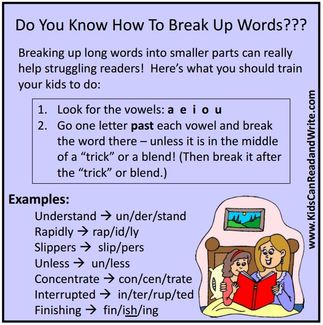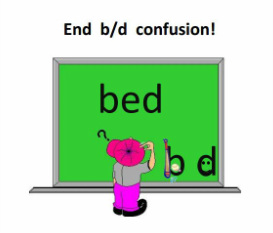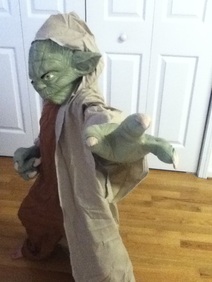
To help prevent future freak outs and ease your kids' anxieties over long words (as well as to improve your kids' reading and comprehension skills), teach your kids to tackle these literary giants with grace and ease. Begin by telling them that reading long words is one of your favorite things to do and that you can't wait to show them how to do it! Then tell them that big words are simply made up of smaller words/parts, and that you will teach them how to read the big words one smaller word/part at a time. Let them know that in no time, they will be MASTERS at reading those currently-intimidating storybook monsters...and that you will be super patient (and will help them as much as necessary) until that time comes. Be excited as you prep them for this new adventure, and make sure you follow through on your promises to be patient!
Breaking Up Long Words -- the Easy Way!
Once your kids are emotionally ready to tackle this new quest, it's time to actually show them what to do! First, tell your kids to find the vowels (a, e, i, o, and u...and sometimes y). Have them start at the beginning of the word when they do so. You can have them underline the vowels that they find, if you want. After they have found all of the vowels, have them start at the first vowel and go one letter past it before drawing a line to break up the word. Make sure your kids don't break up vowel pairs or other "tricks" or blends as they do so. Tell your kids to continue to go through the word in this manner until they get to the end of the word (or until only one letter would be left). The point is to break the word into smaller parts (not into single letters), so have them avoid breaking the word up at the very end if only one letter would remain in the final chunk. Likewise, there is no need to put a line at the very end of a word. When they are done, each segmented chunk should have at least one vowel with it, even if that vowel is a y! As they get more proficient at spotting the vowels and breaking up words, encourage them to create the chunks in their minds as they read the word (as opposed to stopping to underline the vowels and actually draw the lines). This will make reading long words a faster process. But, if actually breaking up the word helps them to read better, by all means, let them underline and segment!
Examples:
insisted --> in/sis/ted
operate--> op/er/ate
treatment--> treat/ment
underneath --> un/der/neath
illustrate --> il/lus/trate
lemonade --> lem/on/ade
supported --> sup/por/ted
continent --> con/tin/ent
understand --> un/der/stand
deliver --> del/iv/er
thermometer --> ther/mom/et/er
hesitantly --> hes/it/ant/ly
suspended --> sus/pen/ded
Sounding the Word Out
After your kids have broken up the word in question successfully, it's time to have them sound it out! Tell them to sound out one chunk/segment at a time, putting each part together before moving on to the next one. Make sure you praise and/or help your kids as they work through each segment. Point to the letters they should be sounding out as they do so. This will help them keep their eyes focused. It should also reinforce that the letters will tell them what the word says, if only they will stick to them and read all the way until the end.
Once your kids have sounded out all of the segments in a given word, it's time to put the segments together! Point back to the first segment, and slowly move through the rest, having your kids say the completed segments as you point to them. Be careful not to let big pauses separate them. Ideally, you want to go from one segment to the next, without any long or hesitant pauses. If necessary, stop and let your kids resound out any forgotten or botched segments. Continue to repeat this process until your kids can say each segment correctly when you point to it. They may need to go through the word a few times before they can do this quickly enough to "hear" the word being said. They may also need to play with which syllable gets the emphasis. That's normal for beginning readers. Be patient and help your kids blend the segments together as you go back through them, putting less and less of a pause between each one as you do so. "Hearing" the word being said is easier and more natural for some kids than for others. If your kids are having trouble "hearing" the word being said, tell them to continue sounding out the word until they can hear it. Remind them to emphasize different syllables, if needed. Help them slowly blend the syllables together if they just can't get the word on their own.
Dealing With Processing Issues
If your kids struggle to keep the segments straight and begin switching sounds around, creating new words, you'll need to go even slower through this process. Re-emphasize each segment, making sure your kids have the individual parts back in their brains properly. Then help your kids put the first two segments together. Add one more segment at a time, until the whole word has been fully reassembled.
Kids with processing issues often spontaneously rearrange random sounds and/or chunks when putting multi-syllable words together. They can't help it, and will likely need extra help (and a lot more patience) when learning how to read 3 or 4 syllable words. Be patient and supportive, and keep going through the current word slowly until all of the parts get reconnected properly. If you are sounding the words out correctly, this process should get easier and easier over time, but with processing issues, there is no guarantee.
In any case, try to ease any anxiety your kids might have, and just keep going through whatever troublesome word is getting mixed up good-naturedly until it is discovered, once and for all. As you do so, make sure your kids' eyes are staying focused on the letters and not lifting up to look at you. Make sure any struggling kids are not fidgeting as well; oftentimes, a twirling finger or roaming hand can be just enough to distract the brain from being successful. Review troublesome words often to help your kids get more comfortable with them.
Making Sure the Foundation is in Place
Of course, for this method of segmenting big words to work, your kids will need to understand how to read small words/blend sounds together. They'll also have to be familiar with the many phonetic "tricks" that will pop up along the way. Oftentimes, kids who have trouble reading long words are also unfamiliar with the many "tricks" that are found within them. They may also need help with basic blending and/or letter sounds. Work on these as needed.
If you need help teaching your kids the many "tricks," you can order our Trick Practice Cards -- Set 1 and our Tricks Practice Cards -- Set 2. These cover almost all of the "tricks" your kids need to know. You can also use our Free Word Card Program. This will help your kids practice each "trick" as they learn them. If you don't feel comfortable teaching your kids the "tricks" and/or how to read, consider looking for a good tutor in your area. Dyslexic students and other struggling readers often do very well once taught phonics through an explicit, systematic approach.
Wishing You Luck...and MUCH Success!
Good luck and let me know if you have any questions! When practicing long words in isolation, don't forget to have your kids tell you what each one means and/or use it in a sentence! When reading long words in books that you can't write in, simply have your kids use their fingers to locate the vowels and/or break them up! You can check to see if they know what the word means after they have read it and/or have finished the sentence it was contained in.
Remember -- reading should be FUN! Help your kids learn to enjoy it by teaching them what they REALLY need to know to figure out those long, unknown words. Before you know it, they will be FREAKING OUT over how good the book they are reading is rather than how long the words are within it!
Wishing you all the best and much success,
Katy Huller


 RSS Feed
RSS Feed